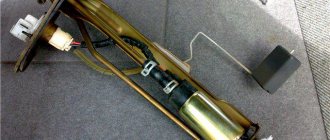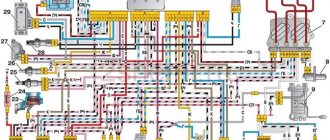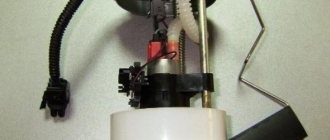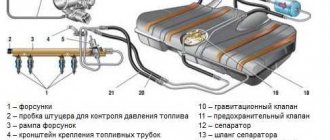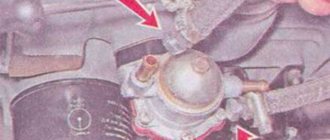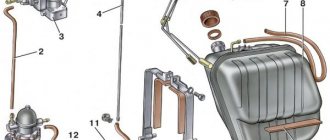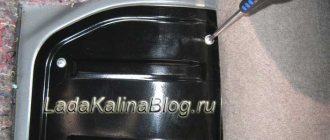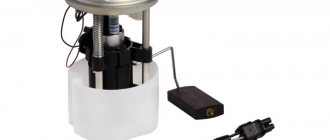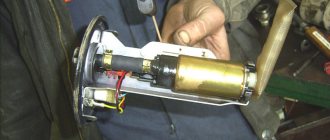1 liter of gasoline - how many kilometers is enough ➡ online calculator will help you calculate the actual distance and fuel costs. How many kilometers does 5, 10, 20, 100 liters of gasoline last? How many liters does it take for 1, 10, 100 kilometers?
1 liter of gasoline will really last for how many kilometers?
Fill in all fields of the calculator. 1 liter of gasoline is set by default. For those wishing to make a calculation for a different amount of fuel, you must replace it with your data: 5L, 10L, 20L, 100L, etc.
The calculation takes into account the fuel consumption per 100 km of travel by your car. Reference data can be found in the drop-down list below (*-Fuel consumption-) for most domestic and foreign cars Renault, Ford, Gazelle, Skoda, etc.
To calculate the material costs (rubles) for covering the entire route, we indicate the cost of 1 liter of gasoline
At the end of the calculation, we will receive the following answers:
- fuel costs (rub.)
- how many liters of gasoline are used for 1 km, 10 km, 100 km (l)
The interactive online calculator also works on mobile devices, it is possible to print the results CTRL+P
If the table does not contain data on the gas consumption of your car, write in the comments the liters and make of the car, we will add it to the list
An online fuel consumption calculator will calculate the distance you want to travel with your car and the cost of the trip.
The calculator offers three columns: - the number of kilometers you are going to drive by car; — average liquid fuel consumption of your brand of car per 100 kilometers, in liters; — the cost of fuel established in your region.
After entering the necessary data, you get the result: how much fuel you will spend during the trip and for what amount.
How much is the reserve?
The light came on - how many liters are in the tank and how much will it last? It all depends on the make and model of the car, but on average it is about 5-8 liters, on which the car can reach about 50-80 km before refueling.
Here, for example, is what manufacturers write in the instruction manual.
Renault Duster: “If it lights up orange while driving and is accompanied by an audible signal, fill the fuel tank as soon as possible. The remaining fuel will be enough for no more than 50 km.”
Peugeot 308: “From the moment the light first comes on, there is less than 6 liters of fuel left in the tank.”
Everything is very approximate, because, firstly, not all manufacturers indicate the reserve stock, and secondly, even if there is a specific figure, the available mileage will be tied to fuel consumption, and that depends on the modification and driving conditions. Take the Hyundai Creta for example. The version with the 1.6 engine, manual transmission and front-wheel drive has a declared consumption of 6.8 liters, version 2.0 with automatic transmission and AWD – already 7.7 liters. With a conditional reserve of 5 liters, in the first case we get about 73.5 km, in the second – 65 km.
By the way, in modern models, in addition to the pointer itself and the warning lamp, the on-board computer usually also shows the power reserve. In some cars, when the signal comes on, the counter abruptly resets to zero, although recently it promised 80-90 km of travel; in others, it continues to count down. But in any case, you need to understand: when it comes to reserve, you have 30-40 kilometers left, and then depending on your luck.
Gasoline consumption standards
This value is necessary for accounting calculations where the enterprise has official transport. Thus, the costs of fuel and lubricants are kept track of. Gasoline consumption standards are required for:
- travel cost calculations;
- maintaining tax and accounting records;
- accounting of expenses for each driver.
If the vehicle does not have an on-board computer, then the fuel consumption calculator will be calculated using the formula:
fuel consumption per 100 km = amount spent in liters / distance traveled (based on city or highway) * 100
In this option, the average value of fuel consumption is taken from the specification for the transport or according to the order of the organization.
Depending on the use of the vehicle, the calculator may include various corrections:
- Seasonality (South from 5 to 7%; Center and Urals from 10 to 12%; Siberia and North 15%; Far North from 18 to 20%).
- Vehicle age (from 5 to 8 years and mileage over 100,000 km – 5%; from 8 years and mileage over 150,000 km – 10%).
- A trip in a populated area (there may be different coefficients for each city) or along the highway. The following rule applies depending on the population in the city: more than 3 million – 25%; from 1 to 3 million – 20%; from 250,000 to 1 million – 15%; from 100 thousand to 250 thousand – 10%.
If the car is equipped with climate control and air conditioning, then an additional factor of 7% is applied to the calculator.
When transporting heavy loads - from 15 to 35%.
For any cargo vehicles (even without cargo), a 10% correction factor is added to the calculator.
Reach to gas station
In the city or near it, problems are unlikely to arise: usually the nearest gas station is a few kilometers away. On the track it's a completely different matter. So when the warning light comes on, the following quest may be born: the range is approximately 50 km, and before refueling - 70. How to hold out?
Here are the basic rules:
- keep the speed at 80-85 km/h (we are talking about the highway and mean a passenger car), use higher gears and do not spin the engine above 2000-2200 rpm when driving evenly;
- we avoid unnecessary acceleration and deceleration, try to maintain a constant speed;
- in urban conditions, at every opportunity, we release the gas pedal, remaining in the selected gear to provide engine braking (applicable for manual and robotic gearboxes);
- turn off powerful energy consumers (air conditioning).
The sooner you turn on the economy mode, the higher the chances of making it to the gas station, especially if your driving style was, to put it mildly, different before. It is more difficult if you have already adhered to the rules described above. You can improve efficiency only by taking more decisive actions: working with tire pressure, using a slipstream behind the vehicle in front and coasting, but this is already in the “extreme” category.
Factors affecting fuel consumption
When thinking about how to calculate fuel consumption and determine the cost of a trip, you need to know what factors influence the final result.
What to pay attention to:
- Technical condition of the vehicle - at first the engine requires more fuel, after the run-in is completed, the consumption returns to normal, and then increases again;
- Moderate driving style - helps reduce performance;
- Weather conditions - the colder it is outside, the more fuel is used;
- Energy consumers - constantly running air conditioning significantly affects performance;
Also requiring attention are the presence of open windows, insufficiently inflated tires, type of tires, tire size, unheated engine - all this affects the result.
After fasting
The fuel ran out and the engine stalled. What does this mean for technology? With a one-time “starvation”, the risk of serious consequences is small, but there is little pleasant for the fuel system, especially for diesel versions, where there is a possibility of airing.
In addition, even after refueling, the first start may be difficult. Here we turn again to the instruction manuals.
Here's what Renault says: “Boosting pump (diesel engine versions). If the fuel runs out completely (which should be avoided), the fuel circuit must be refilled before starting the engine. Note: The manual fuel priming pump is located on the right side of the engine compartment. Using a manual fuel priming pump 5, pump the circuit until fuel flows into tube 4. If the engine does not start after several attempts, contact an authorized dealer service station. If the fuel in the tank has run out (on a diesel version).
Engines other than BlueHDi. Fill the fuel tank with at least 5 liters of diesel fuel. Open the hood. If necessary, remove the cover to provide access to the fuel pump. Make several pumps with the booster pump lever until you feel noticeable resistance (the first press of the lever may be hard). Turn on the starter, start the engine (if the engine does not start on the first try, wait about 15 seconds and repeat). After several unsuccessful attempts, refill the fuel with the pump and start the engine. Replace the protective cover and secure it.
BlueHDi engine. Fill the fuel tank with at least 5 liters of diesel fuel. Turn on the ignition (without starting the engine). Wait about 6 seconds and turn off the ignition. Do this 10 times. Turn on the starter and start the engine."
Other brands may have different requirements. In general, study the materiel.
The solution of the problem:
Let's write down the formula for determining the coefficient of performance (efficiency). By definition, efficiency is the ratio of useful work to expended work.
The useful work \(A_п\) can be easily determined through the car engine power \(N\) and the travel time \(t\), and we find the latter as the ratio of the path \(S\) to the speed of movement \(\upsilon\).
The work expended \(A_з\) is equal to the amount of heat that is released during the combustion of gasoline, therefore:
The specific heat of combustion of gasoline \(q\) is 46 MJ/kg.
We write the mass of gasoline \(m\) as the product of the density of gasoline \(\rho\) (it is equal to 700 kg/m 3) and the volume \(V\).
Let us substitute the resulting expressions (2) and (3) into formula (1).
From this formula we express the desired path \(S\):
Let's convert the volume of gasoline \(V\) into cubic meters, the car speed \(\upsilon\) into m/s, and the engine efficiency \(\eta\) into fractions of units:
Let's calculate the numerical answer to the problem:
What are the consequences of constantly driving “with a light bulb”?
Above we looked at a situation where almost all the fuel was used up. But when the light just comes on, there is still some reserve, which means you can safely drive another 20 kilometers? Yes, there are people who constantly drive with an almost empty tank. And there is a widespread belief that it is harmful.
The arguments are as follows. Regardless of the type, the fuel pump is cooled by the fuel in it, and the submersible type is also cooled by the fuel around it. Accordingly, without liquid, the pump heats up; running “dry” quickly disables it. Regardless of the placement of the pump, fuel is taken from the bottom of the fuel tank, and the less fuel, the greater the risk of airing the system, and the greater the concentration of contaminants that accumulate in the tank over time, the greater the load on the filter elements and the reduction in their service life. Running the engine intermittently can damage the catalyst.
Even in theory, there are counterarguments to these arguments. Not all electric pumps are of the submersible type, but even submersible ones, as a rule, are located in a module (in a plastic cup), external cooling with fuel there is very conditional. In principle, a “dry” pump will not work for a long time: if there is no fuel, the engine will simply stall, and the pump will also stop. Is there a risk of air pollution or increased concentration of dirt when the fuel level is low? This is counteracted by the design features of the tank and pump module (anti-drain walls, filter elements). And if there is a lot of contaminants in the tank, this is already a problem, regardless of the amount of fuel.
As for practice, there are no clear statistics on this matter, and in general, the specialists surveyed, including practicing mechanics, do not have a clear position on this matter. Yes, constant driving with a low fuel level will not add “health” to the pump, but no one could imagine many cases confirming such a dependence. In general, everyone agrees that one-time trips “on the light bulb” (but without completely running out of fuel) will not damage the pump. However, this should not be turned into a system: the more such trips, the higher the likelihood that the fuel will run out completely on some trip, and running the pump “dry” is definitely harmful.
What faults increase fuel consumption?
The ability to calculate the amount of fuel used helps to carry out initial diagnostics of your car. Deviation of the most popular indicator often indicates serious violations in the operation of transport components and mechanisms. This fact can be confirmed by a cross-section of indicators on absolutely identical car models.
The first reason for the increase in fuel consumption lies in clogging of the fuel system elements. A clogged air filter or injectors will increase the load on the fuel pump. In the first case, there is no standard enrichment of the mixture, which is supplemented by the same gasoline. In the second case, the addition of fuel to the cylinders is not complete, a new portion of fuel is required, and the engine speed increases.
Electronic malfunctions or air conditioning malfunctions contribute to an increase in the rate of fuel combustion, as does a worn canister. Consumption is also affected by a violation of the mounting parameters of the discs and too viscous oil.
Timely elimination of car malfunctions, changing driving style and operating habits will reduce the cost of maintaining a car in terms of the most important item - fuel consumption.
Do you like to play roulette?
It is clear that the real range for your car and for typical conditions (city, highway) can be determined experimentally: take a canister of fuel with you and measure the mileage from the moment the warning light comes on until the car begins to twitch. There is only one question: why? Probably, every driver with experience has had stories when, by coincidence, he had to make it to the gas station “on fumes,” but that’s what they are stories for, that is, exceptions to the rules. Why take it to “extreme”, especially on an ongoing basis?
Actual fuel consumption may differ from the declared one, the nearest gas station on your route may not work, and finally, the fuel level sensor on your car may be lying. In general, there are enough risk factors for someone to play a bad joke on you. And according to Murphy's law - at the most inopportune moment.
So here’s some banal advice: when the fuel gauge needle approaches the minimum value, refuel, preferably immediately until the tank is full. Constantly topping up 5 liters each does not give any savings, on the contrary: you will have to stop at a gas station next week, spend extra time, kilometers (and therefore fuel) on it and refuel for one penny more.
Spare parts for passenger cars in the Automotive Business ad database
How to reduce fuel consumption?
Is it possible to save fuel simultaneously with a sharp reduction in smoke and emissions into the surrounding atmosphere? Maybe it's a myth?! No, this is reality, which has been repeatedly proven by scientific research into the effects of RVS treatment and thousands of happy reviews from car owners.
RVS-Master, by modernizing the friction surfaces, solves several problems at once. It can be called a universal composition that helps reduce diesel consumption, and therefore is used with equal success for special equipment and modern, expensive luxury cars.
FIELD OF APPLICATION The repair and restoration composition allows you to reduce the fuel consumption of gasoline and diesel power units installed on various equipment:
- Cars.
- Motor transport.
- Special equipment.
- Boats.
- Snowmobiles and ATVs.
- Lawnmowers and chainsaws.
Read more
Basic standards for calculating fuel consumption
Standards for calculating fuel consumption
The cost rate for fuels and lubricants is the average amount of fuel and lubricants consumed for certain types of vehicles, taking into account the distance traveled.
According to the recommendations of the Ministry of Transport of the Russian Federation for 2016, enterprises have the right to calculate the consumption of fuels and lubricants that have vehicles on their balance sheet independently, or taking into account the requirements. The main document that guides enterprises is Order of the Ministry of Transport of the Russian Federation N AM - 23 - p dated March 14, 2008.
In 2015, the increasing coefficients for operated transport in the city, where the population is more than 5 million people, underwent minor changes. In addition, by Order of the Ministry of Transport of the Russian Federation N - 80 - p dated July 14, 2015, the list of vehicle models for organizations and enterprises has been expanded.
Fuel consumption calculation
Basic rates are adjusted taking into account the following coefficients:
In winter: Far North, North, Siberia from +15% to +20%; Center, Urals from +10% to +12%; Southern regions from +5% to +7%. Based on the number of people living in the urban district where the vehicle is operated: up to two hundred and fifty thousand +10%; up to one million +15%; up to three million +20%; more than three million + 25%. In addition, the mileage and year of manufacture of the vehicle are taken into account; connecting the interior cooling system (air conditioning); movement of large cargo, as well as the type of fuel and lubricants being refueled.
How to determine fuel consumption
The calculation algorithm is based on the fuel consumption formula, where the value of the first indicator is divided by the second value in the calculator. It is preliminary because it does not take into account a number of factors.
To determine the amount required to purchase fuel, you need to set the cost of 1 liter of fuel in the region. The fuel consumption calculator per 100 km determines the volume of fuel and the amount needed to purchase it, based on reliable data obtained in practice.
Steps to determine current gasoline consumption for a specific car:
- Fill up your vehicle's tank at a gas station;
- reset the odometer on the dashboard;
- drive 200-300 km as usual, not only on the highway, but also on city streets, braking at pedestrian crossings and stopping at traffic lights;
- Refill with fuel again before the fuel dispenser trigger releases.
Why you can’t fill up your car for “500 rubles”
Fuel is now considered “per liter” mainly by those who use bank cards to pay. In this case, it doesn’t matter what “kopecks” the amount written off turns out to be: you won’t have to search your pockets for small change and the cashier won’t give you a bunch of coins in the form of change.
And citizens who pay in cash usually fill up “for so many rubles.” It’s more convenient for them to hand over a bill at the checkout and, again, not bother with change. But in this case, the absence of change and the need to keep change coins in your pocket is achieved solely at the expense of the car owner and with a small, but unaccounted profit for the gas station.
Or rather, for its staff. This happens as follows. Let’s say a person wants to fill his car with AI-95 gasoline for the amount of 500 rubles. For many city dwellers driving the most popular car models, this amount is the most comfortable for various reasons. So, he gives the “five hundred” to the cashier and returns to the car standing at the gas pump.
Few people think about it, but in fact, this very column, among other things, is a measuring device that measures the required volumes of liquid (fuel, that is). Like any measuring equipment, it has its own error.
Thus, modern dispensers measure gasoline with an accuracy of 10 ml - 0.01 liters. And so, you pay 500 rubles. Now the price of 95th is 46 rubles per liter. You can find both more expensive and cheaper, but to simplify the explanations, we will accept the above cost per liter. In theory, for 500 rubles 10.86956 liters of gasoline should go into the tank. But the dispenser can physically pour either 10.86 liters (less than what was paid for) or 10.87 liters - that is, more.
Not a single gas station will engage in charity, so there will be an underfill of 0.00956 liters (almost 0.01 liters). That is, the car owner will give about 40 kopecks from 500 rubles to the gas station. And the cash register receipt will most likely show 499 rubles 60 kopecks.
About a hundred cars can pass through a gas station located in a busy place in a day, refueling “for rubles.” 40 kopecks each - enough for tea and sandwiches for the staff. It's a small thing, but nice.
Source
There are pitfalls in this situation that not everyone is aware of.
Automotive experts explained the dangers of refueling a car for a certain amount, PRIMPRESS reports with reference to the AvtoVzglyad portal.
Drivers at gas stations are usually divided into two types. The former prefer to refuel their car, indicating a certain number of liters, while the latter are based primarily on the amount, saying that they need to refuel “500” or “a thousand rubles”.
At the same time, those motorists who pay by card mainly think in “litres”, since they do not plan to look for “pennies” to accurately pay the bill. But the second category of drivers pays in cash.
And in this case there is a catch. Indeed, in such a situation, the motorist unknowingly makes additional profit for gas stations.
The thing is that gas pumps have measurement errors. Take, for example, the cost of gasoline at 46 rubles per liter.
In theory, for 500 rubles 10.86956 liters of gasoline should go into the tank. But the dispenser can physically pour either 10.86 liters (less than what was paid for) or 10.87 liters, that is, more.
Not a single gas station will engage in charity, so there will be an underfill of 0.00956 liters (almost 0.01 liters). That is, the car owner will give about 40 kopecks from 500 rubles to the gas station. And the cash register receipt will most likely show 499 rubles 60 kopecks.
Thus, a decent amount can accumulate in a whole day, which results in additional profit for gas stations and a kind of “deception” of drivers, the publication notes.
Source
Why is clearance needed and what does it affect?
Clearance is explained by GOST as the distance between such parts of the car as the supporting surface and the lowest point of the central part of the entire structure. Simply put, this is the distance that separates the prospect of damaging the lowest part of the car and the road surface. More often, this concept can be heard in such a form as ground clearance - it is more understandable, easier to remember and therefore used with great pleasure.
The amount of ground clearance is a very important characteristic for any car, as it significantly affects stability at high speed, cross-country ability, and maneuverability. And these, without a doubt, are the indicators that can demonstrate the car in the best light. As for cross-country ability, it can be increased along with an increase in value. By the way, this can be done while driving – on some cars.
As a rule, ground clearance is indicated in millimeters, sometimes also in centimeters. It is also common practice to notify car owners about two values - clearance under the front and rear axles. Sometimes they even indicate the clearance that is under the engine crankcase.
To make it easier to characterize clearance, in the future, using a table, a conditional classification of this characteristic should be given. In general, ground clearance can be divided into three categories: high (SUVs and SUVs), medium (crossovers and SUVs), small (passenger cars). And now regarding the specific values of ground clearance under the front bumper:
- 20-35 cm for SUVs.
- Not less than 18 cm and not more than 25 cm for SUVs.
- 14-20 cm for cars.
As for the oil pan, these are the following values:
- From 20 cm for SUVs;
- From 17 to 21 cm for SUVs;
- From 12 to 17 cm for passenger cars.
A gas station attendant I know told me why you need to fill up in liters and not for a certain amount of money.
It's no secret that a customer at a gas station has several options for refueling his car. Some people focus on a set amount of money, but most still prefer to fill up a certain displacement. There are those who always fill “to full.” But as practice shows, the number of such motorists is inevitably going down.
I have one good friend who worked at a local gas station for 5 years, first as a gas station attendant and then as an administrator. So, during the next conversation, Slavik shared interesting data regarding the operation of the speakers themselves.
